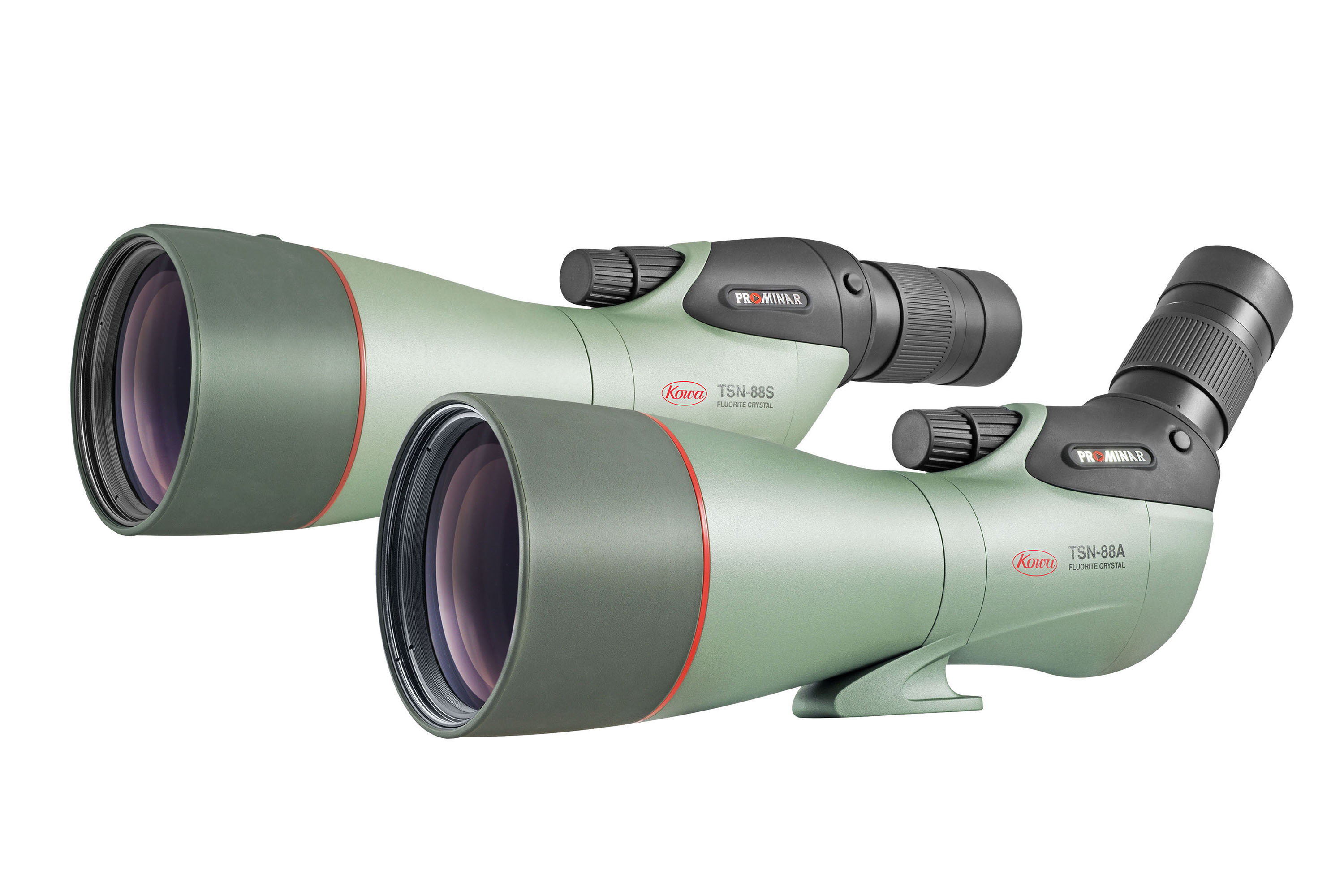Kowa TSN 88A Prominar Telescope
Over the last two years, Kowa has changed gear and entered a 'remake and remodel' phase, which has seen a highly upgraded 66-mm telescope (see Birdwatch 376: 60-61) and the introduction of a new 99-mm model.
The TSN-88 Prominar follows the same lines as the TSN-99, adopting the same modernistic design and form, including all the built-in ergonomic and optical improvements. From a practical perspective, the new 88 has been engineered to be 'tougher and lighter' than its predecessors in the TSN-880 series, the aluminium barrel and magnesium prism housing of the latter now having been replaced with a 100% magnesium alloy body.
In keeping with the new family appearance, there is a stylish 'continuation contour' from the tripod foot to the underside of the prism housing, above which sits a black rubber shawl bearing the Prominar epithet. The only other use of rubber on the otherwise anodised body is the covering on the pull-out objective lens hood, the latter incorporating a newly designed sight to facilitate lining up the scope with the subject to be viewed.
In common with the TSN-99, the objective lens filter ring is now located on the body instead of on the lens hood, meaning that if a protective filter is fitted, it will not collect rain or dirt when the hood is fully extended. The protective lens cap also clips into the objective housing and not onto the lens hood, which is a pity given the fact that birding in the rain requires general use with the hood extended.

In addition to rotating 270° around the body and locking at seven evenly spaced points, the tripod foot takes on a new, curved shape. It also includes an extra screw port that allows the scope to be attached using two screws to any quick-release plate with this attribute, thereby ensuring no accidental rotation and increasing stability when mounted on a tripod.
Unlike the slightly heavier-ended TSN-99, which tends to tip forward, I found the 88 to be perfectly balanced when tripod-mounted, although an ARCA-SWISS-style tripod foot would solve any potential balancing and stability issues for all scopes in the range, had the design initiative been taken.
There have been a number of optical improvements which, I have to say, elevate this scope well into the premier league.
Lifting the hood, the prism assembly takes on an enhanced design. New optical coatings have been developed for, and applied to, the prism system, as well as to the lenses themselves. The resultant effect is higher levels of light wavelength transmission across the entire colour spectrum.
This is all in addition to the trademark fluorite crystal objective lens and the overall combination is designed to increase contrast and resolution and give better performance in low light conditions. Most importantly, it has been implemented to 'eliminate' chromatic aberration (CA). That, some may say, is a big ask but when I look back at how well these measures worked together when I reviewed the TSN-99, I can only repeat what I thought at the time – which was, simply, 'wow!'
Trying to find any CA in the image delivered by the 88 is a challenge. I spent a good deal of time watching gulls, Eurasian Coots and Great Cormorants against a variety of backgrounds – particularly brightly lit water, which throws up colour fringing at its worst when observing birds. Yes, it's there, but it's very difficult to see, even at the periphery of the image.
So, drilling deeper into the optical performance, it becomes obvious from the outset that this telescope quite simply delivers an impressive image and, of course, there is a choice of eyepieces. The scope body employs a securely locking bayonet fitting system that allows connection and release by push-button of the 35x TE-80XW Extreme Wide Eyepiece and the 25-60x TE-11WZ II Wide Zoom Eyepiece, both of which I had the pleasure of using. At this point, it's important to mention that the historical TSN-880/770 eyepieces are also compatible and work perfectly with TSN-88.
The eyepieces share some similarities. Both have a rubber-covered eyecup that twists out, click-stopping at three positions above the base setting, and I was pleased to be able to see the full field of view when both were fully extended. Comparing them at 35x magnification, there was no difference in the amount of turning of the rubber-ribbed dual focusing wheels to achieve a sharp focus over the same distances.
While there is a noticeable difference in the field of view at 35x, it is not what I would call significant and it's soon forgotten when using the zoom at higher magnifications.
The sharpness of the image is splendid when using both eyepieces and remains so, virtually to the edge of the field and at all magnifications. The use of field-flattening elements also removes any peripheral distortion. A high degree of brightness is also a boon to observation and does not diminish too much at the highest magnification of 60x, while there is an overall cold or neutral tone to the colour rendition. I found the colour reproduction itself to be both natural and accurate in all environments.
Overall, this is a seriously impressive telescope and I would opt for using the zoom eyepiece if faced with having to choose between the two. Accessories from digiscoping and phonescoping adaptors to stay-on cases are also available separately.
Further info
- Price: £2,679 (TSN-88A body only); £690 (TE-11WZ II Wide Zoom Eyepiece); £649 (TE-80XW Extreme Wide Eyepiece
- Size: 342 mm (TSN-88A body only)
- Weight: 1,460 g (TSN-88A); 380 g (TE-11WZ II); 485 g (TE-80XW)
- Magnification: 25-60x (TE-11WZ II); 35x (TE-80XW)
- Field of view at 1,000 m: 42-23 m (TE-11WZ II); 45 m (TE-80XW)
- Light transmission: n/a
- Close focus: 5 m
- Gas-filled: yes
- Waterproof: yes
- Guarantee: 10 years
Verdict
+ Phenomenal image quality
+ Near-total lack of chromatic aberration
- Lack of ARCA-SWISS tripod foot


